The flatheaded appletree borer (FAB) (Chrysobothris femorata) (Coleoptera: Buprestidae) (Fig. 1) is a polyphagous (feeds on multiple tree species) pest native throughout North America that impacts specialty crops such as fruit, nut, and ornamental trees. In Georgia, nursery growers face mild to moderate levels of infestation depending on local beetle population size and favorable environmental conditions. Adult FABs are metallic greenish-bronze and appear flattened in cross-section, leading to “D” or oval-shaped exit holes (Fig. 2) that are associated with buprestid beetles. Exit holes are made by the adult beetles as they emerge from the wood. The elytra (wing covers) of the FAB adults have markings that appear as light-colored “zigzagging” bands. Larvae are cream-colored and have an enlarged, flattened thoracic segment behind the darker true head of the insect, giving them the name “flatheaded” (Fig. 3).
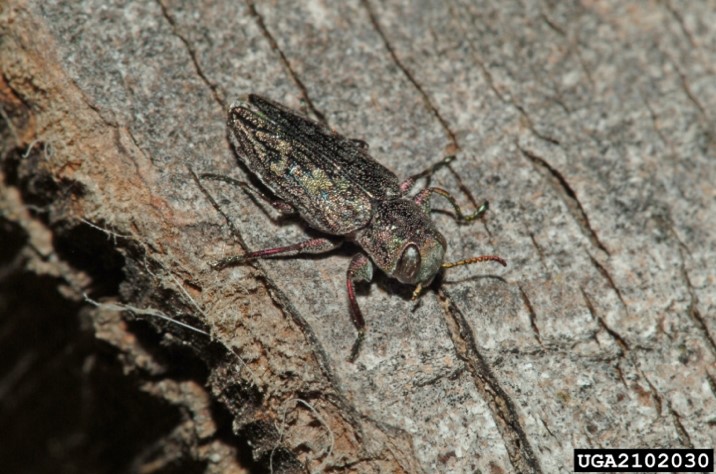
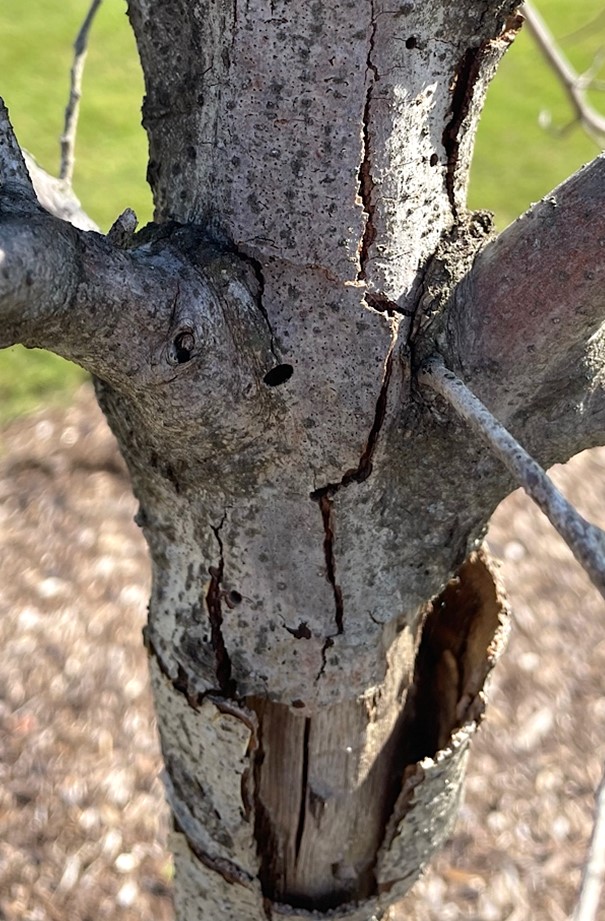
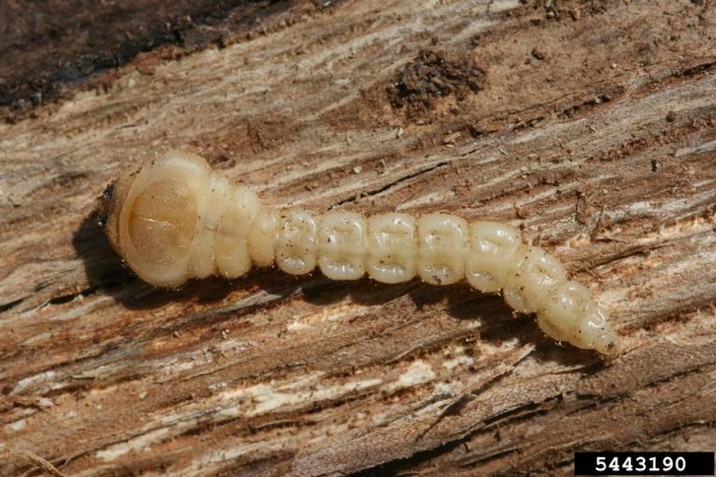
Biology
FABs have one generation per year. Adults emerge from wood members from spring to summer. They mate and lay eggs either in the crevices of the bark of their host tree or other trees, primarily in the lower trunk area (lower two feet). Up to 100 eggs may be deposited at a time, either individually or in small groupings. After 15 to 20 days the eggs hatch and larvae bore directly into the tree, feeding beneath the bark. The feeding produces a “pocket” tunnel that from the outside appears water-soaked and manifests itself as frothy liquid exudate on the bark. The final larval stage overwinter in the sapwood or heartwood of the host tree. Larval feeding leads to damaging tunnels within the cambium, phloem, and outer sapwood (Fig. 4). These tunnels may cause girdling of tree trunks, with attacks over subsequent years potentially proving deadly to those trees.
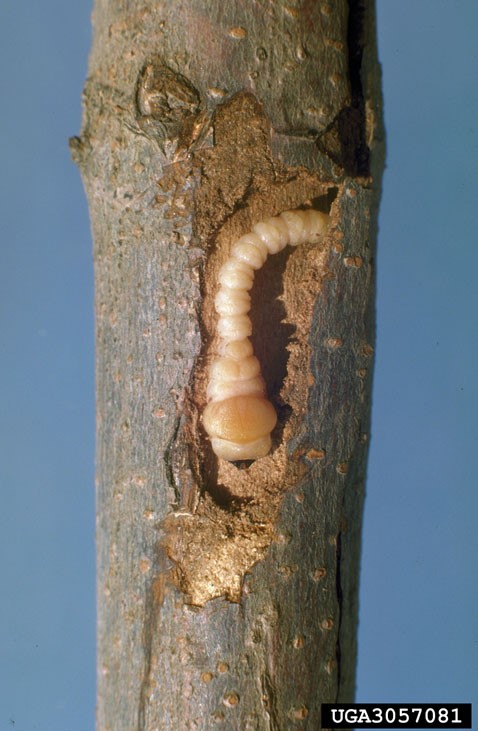
Photo: James Solomon, USDA Forest Service
Damage
FABs pose a serious threat to several cropping systems, including ornamental tree production, fruit and nut trees, as well as trees within landscapes. The FAB has been reported to attack over 30 species of trees, demonstrating the wide host range of the insect.
Most economic damage from the FAB is caused by the larval stage of the insect. This is due to the tunneling of the immature insects disrupting the vascular system of the tree (Fig. 4), leading to an inability to translocate water and nutrients throughout the plant. Small trees are especially at risk of death caused by damage from FAB larvae. In addition, stressed trees are more likely to attract adult borers resulting in egg-laying as those trees release stress chemicals and increase the likelihood of larvae later causing economically significant damage to trees. FABs are also a major concern in settings where aesthetics are important, such as ornamental production nurseries and landscapes, where the resultant cankers (Fig. 5) can prove unsightly as well as lead to other appearance-oriented issues such as branch thinning and browned foliage.
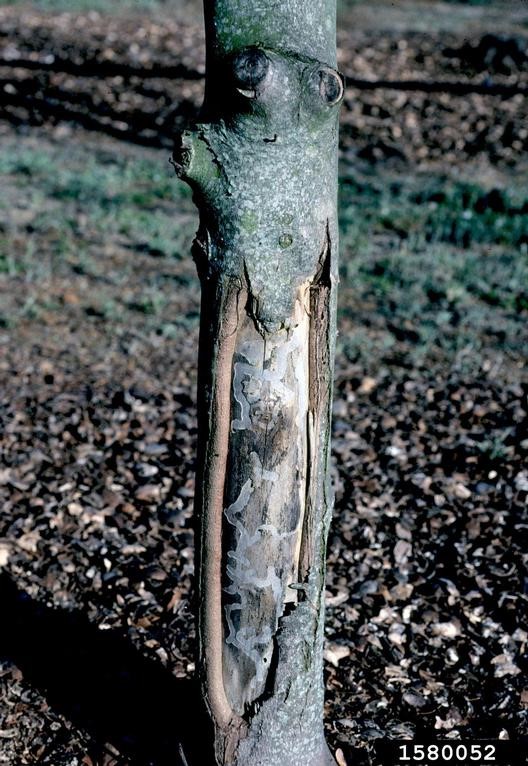
Photo: John Ruter, University of Georgia
Management
While it is difficult to detect the presence of larval insects before the damage becomes visible, early detection of adult FABs using lured traps is still under investigation. It must be noted that due to the location of immature insects under the bark of the tree, spray applications using contact insecticide do not provide effective management of larval insects. If the adult flight is noticed in spring or early summer, preventative drench application of systemic insecticide to the trunk may help in preventing larval colonization of the tree. Furthermore, soil drench applications of systemic insecticides (such as imidacloprid, thiamethoxam) surrounding the base of the tree may provide some utility in managing existing larvae. Please check with the county agent in your county (1-800-ASK-UGA1) for the latest recommendation on insecticides that are effective against this pest. Please follow the insecticide label before the application of insecticide because the label is the law.
Another major component of FAB management is maintaining proper cultural practices. Stressed trees experience increased susceptibility to attack by FABs. Causes of stress can range from trees being recently planted to equipment damage or irrigation issues, such as excess or too little water. Because of this, it is essential to provide proper irrigation, fertilization, and other necessary maintenance to trees.
References
Acebes-Doria, A. L., Joseph, S. V., & Blaauw, B. R. (2019). East coast: Factors affecting borers and management: pecans, ornamentals, and fruit trees. Proceedings of the Annual Research Conference of the Southern Nursery Association, 48, 1.
Beddes, T., Murray, M., & Caron, M. (2014, February). Pacific flatheaded borer and flatheaded appletree borer. Utah State University Extension. Retrieved September 14, 2021, from https://digitalcommons.usu.edu/cgi/viewcontent.cgi?article=1650&context=extension_curall.
Blalock, A., & Oliver, J. (2014). Controlling the flatheaded appletree borer in nurseries with soil applied systemic insecticides. Tennessee State University Extension. Retrieved September 14, 2021, from https://www.tnstate.edu/extension/documents/Controlling%20the%20Flatheaded%20Appletree%20Borer%20in%20the%20Nursery%20Using%20Systemic%20Drenches%20-%20COMPLETE%20VRS..pdf.
Burke, H. (1919). Biological notes on the flatheaded apple tree borer (Chrysobothris femorata Fab.) and the Pacific flatheaded apple tree borer (Chrysobothris mali Horn). Journal of economic entomology, 12(4), 326-333.
Dawadi, S., Oliver, J. B., O’Neal, P., & Addesso, K. M. (2019). Management of flatheaded appletree borer (Chrysobothris femorata Olivier) in woody ornamental nursery production with a winter cover crop. Pest management science, 75(7), 1971-1978.
Oliver, J., Fare, D., Youssef, N., & Klingeman, W. (2004). Collection of adult flatheaded borers using multicolored traps. Proceedings of the Southern Nursery Association Research Conference,
Oliver, J., Fare, D., Youssef, N., Scholl, S. S., Reding, M., Ranger, C., Moyseenko, J., & Halcomb, M. (2010). Evaluation of a single application of neonicotinoid and multi-application contact insecticides for flatheaded borer management in field grown red maple cultivars. Journal of Environmental Horticulture, 28(3), 135-149.
Potter, D. A., Timmons, G. M., & Gordon, F. C. (1988). Flatheaded apple tree borer (Coleoptera: Buprestidae) in nursery-grown red maples: phenology of emergence, treatment timing, and response to stressed trees. Journal of Environmental Horticulture, 6(1), 18-22.